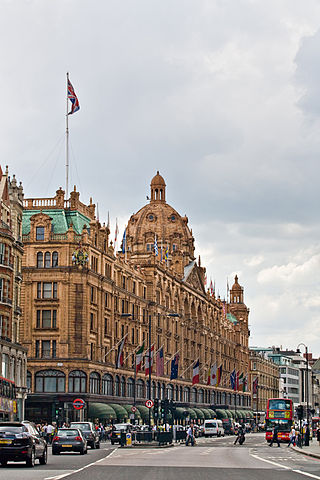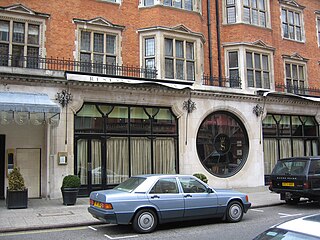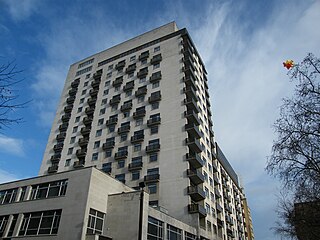
Alan Ross McWhirter was, with his twin brother, Norris, the cofounder of the 1955 Guinness Book of Records and a contributor to the television programme Record Breakers. He was assassinated by the Provisional Irish Republican Army (IRA) in 1975.
The Guildford Four and Maguire Seven were the collective names of two groups people, mostly Irish, who were wrongly convicted in English courts in 1975 and 1976 for the Guildford pub bombings of 5 October 1974, and the Woolwich pub bombing of 7 November 1974. All the convictions were eventually quashed after long campaigns for justice, and the cases, along with those of the Birmingham Six, shattered public confidence in the integrity of the English criminal justice system.
The Guildford pub bombings occurred on 5 October 1974 when the Provisional Irish Republican Army (IRA) detonated two 6-pound (2.7-kilogram) gelignite bombs at two pubs in Guildford, Surrey, England. The pubs were targeted because they were popular with British Army personnel stationed at Pirbright barracks. Four soldiers and one civilian were killed. Sixty-five people were wounded.
PC Stephen Andrew Tibble, was a police officer in London's Metropolitan Police Service. During a chase through West Kensington, Tibble was fatally shot by Liam Quinn, an American member of the Provisional Irish Republican Army.
Hugh Aodh Doherty is a Scottish-born Irish republican, who was a former volunteer in the Provisional Irish Republican Army (IRA), known for his role in the Balcombe Street Siege, in London in December 1975.

Peter Michael Imbert, Baron Imbert, was Commissioner of the Metropolitan Police Service from 1987 to 1993, and prior to that appointment Chief Constable of Thames Valley Police from 1979 to 1985.

The Harrods bombing refers to the car bomb that exploded outside Harrods department store in central London, England, on Saturday 17 December 1983. Members of the Provisional Irish Republican Army planted the time bomb and sent a warning 37 minutes before it exploded, but the area was not evacuated. The blast killed three police officers and three civilians, injured 90 people, and caused much damage. The IRA Army Council said it had not authorised the attack and expressed regret for the civilian casualties. After the bombing, the IRA shifted its emphasis towards attacks on military targets in England.
William Joseph Quinn, known as Liam Quinn, is an American former volunteer in the Provisional Irish Republican Army who shot dead Stephen Tibble, an off-duty police officer, in London on 26 February 1975.
Paul "Dingus" Magee is a former volunteer in the Belfast Brigade of the Provisional Irish Republican Army (IRA) who escaped during his 1981 trial for killing a member of the Special Air Service (SAS) in 1980. After serving a prison sentence in the Republic of Ireland, Magee fled to England where he was imprisoned after killing a policeman in 1992. He was repatriated to the Republic of Ireland as part of the Northern Ireland peace process before being released from prison in 1999, and subsequently avoided extradition back to Northern Ireland to serve his sentence for killing the member of the SAS.
Roger Philip Goad, was an explosives officer with London's Metropolitan Police Service who was posthumously awarded the George Cross for the heroism he displayed on 29 August 1975. He had previously been awarded the British Empire Medal in 1958 for gallantry whilst serving with the Royal Army Ordnance Corps in Cyprus, for repeated acts of deliberate courage in the disarming of bombs and booby traps set by terrorists.
Martin Joseph O'Connell, better known as Joe, is an Irish republican and a former volunteer in the Provisional Irish Republican Army (IRA). He is most noted for having been a member of the Balcombe Street gang.

Ernest Radcliffe Bond, OBE, QPM,, also called Commander X, was a British soldier, and later policeman famous for his service in the Metropolitan Police Service.

Scott's is a seafood restaurant at 20 Mount Street, Mayfair, London. Originating as "Scott's oyster rooms" in Haymarket in the 1850s or earlier, it would become "Scott's Oyster and Supper Rooms" on Coventry Street in 1891, and moved to its present location in Mount Street in 1967. Scott's was a favourite of Ian Fleming. In 1975 it was attacked twice by the Irish Republican Army (IRA).
On Tuesday evening 18 November 1975 an Irish Republican Army (IRA) unit nicknamed the Balcombe Street Gang, without warning, threw a bomb into Walton's Restaurant in Walton Street, Knightsbridge, London, killing two people and injuring almost two dozen others.
The Balcombe Street Gang was a Provisional Irish Republican Army (IRA) active service unit (ASU) who carried out a bombing campaign in southern England in the mid-1970s. The majority of their attacks and attempted attacks took place in London and the rest in Surrey, Hampshire and Wiltshire. Between October 1974 and December 1975 they carried out approximately 40 bomb and gun attacks in and around London, sometimes attacking the same targets twice. The unit would sometimes carry out two or more attacks in one day; on 27 January 1975 they placed seven time bombs in London.

On 19 January 1975 the Provisional IRA's Balcombe Street Gang opened fire with automatic weapons on two hotels in London, England. Twelve people were injured by broken glass. The IRA carried out a similar attack a month before, and attacked one of the hotels again a few months after.

The Talbot Arms pub bombing took place on 30 November 1974, and was carried out by the Provisional Irish Republican Army (IRA). Eight people were injured in the attack, which involved the IRA throwing homemade bombs through the pub's window. Only one of the devices exploded; the other was taken as evidence and used to discover how the unit assembled its devices.
Chief Superintendent Maxwell Stamp Vernon was a British police officer and hostage negotiator. Vernon joined the Metropolitan Police after serving as a military policeman during his National Service. He was involved in the successful negotiations to end the 1975 Balcombe Street siege and afterwards served with the Metropolitan Police's fraud squad. In 1980, as a chief inspector, Vernon led the six-man negotiating team during the Iranian Embassy siege. He thought he was close to resolving the siege peacefully when a hostage, who Vernon thought was intentionally provoking his captors, was shot dead. This led to a Special Air Service (SAS) assault on the building which killed or captured the gunmen and freed all bar one of the hostages. Vernon continued to negotiate until the last moment as a distraction technique and was later commended for this by a member of the SAS team.
Harry Duggan is a former member of the Provisional Irish Republican Army (IRA) and a representative of Sinn Féin in County Clare. He was part of an IRA unit based in England, of which Duggan and three others were labelled the "Balcombe Street Gang" by news media after a five-day siege in the eponymous London Street. He and his co-accused were gaoled for seven murders plus other charges.
Edward Butler is a former member of both the Official Irish Republican Army and the Provisional Irish Republican Army (IRA). He was part of different IRA units based in Ireland and then England. Butler and three others were called the "Balcombe Street Gang" or the "Balcombe Street Four" by news media during a five-day siege in the street of that name near Marylebone station, London. He and his co-accused were gaoled for seven murders plus other charges.








